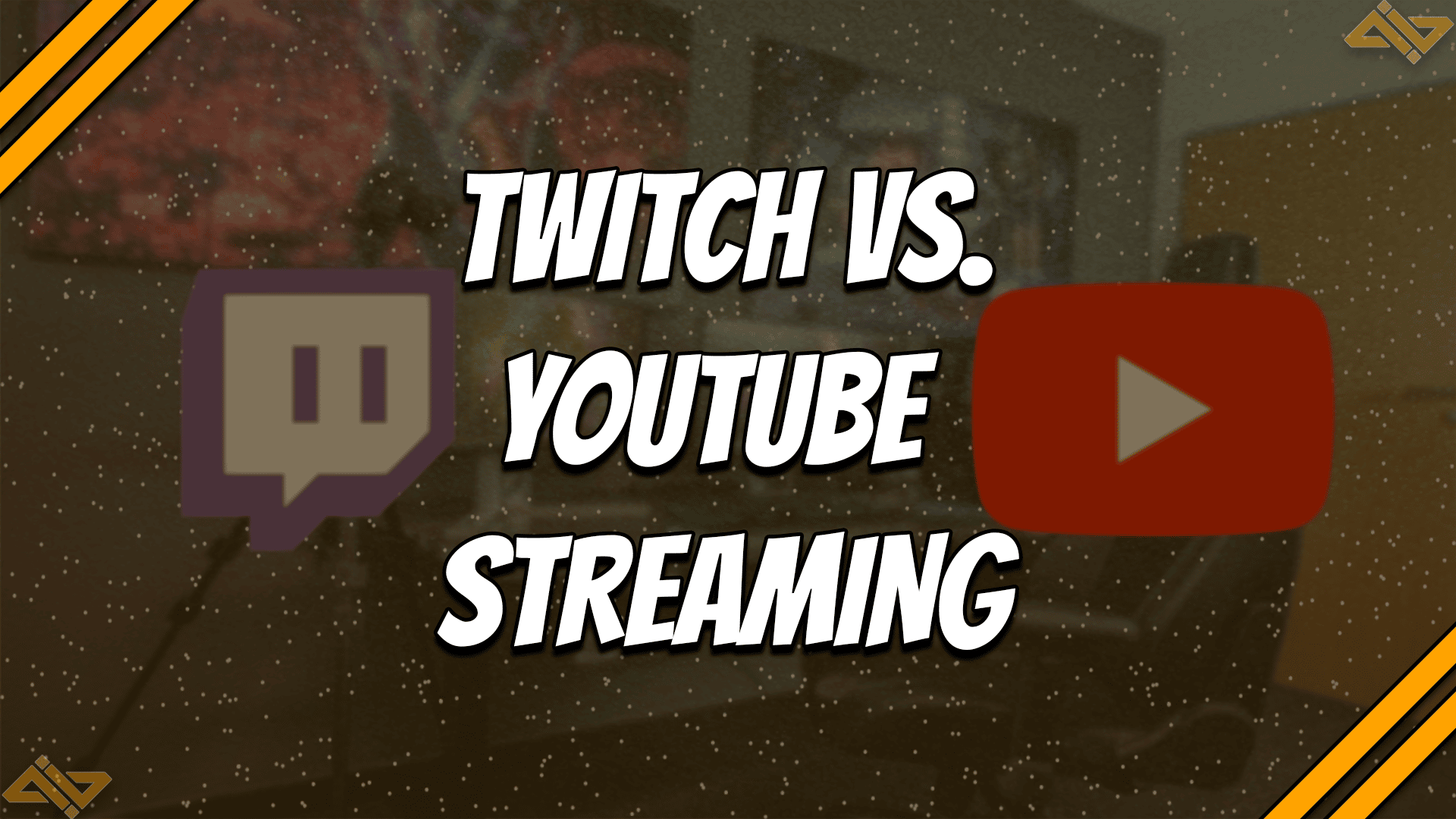Not sure where to start your streaming career? Continue reading to learn more about Twitch vs. YouTube streaming to help you decide.
Choosing where to stream is one of the first important decisions you must make when starting out. It’s a tough choice because of all the excellent available platforms today.
Almost all social media sites and platforms have a live streaming service of some sort because they all want a piece of the industry. However, there’s no question that Twitch and YouTube are the best platforms when it comes to streaming.
This then begs the question, “is it better to stream on Twitch or YouTube?” The Twitch vs. Youtube streaming debate is definitely a hard one to answer. Both have pros and cons and are suitable for different types of streamers.
Don’t worry. We’ve got your back. We’re here today to break down Twitch vs. YouTube streaming, including their pros and cons, differences, and everything you need to know about both platforms.
Twitch Vs. YouTube Streaming

There’s no doubt that Twitch and YouTube are two of the best platforms for anyone to stream on. They are the most popular, offer the best perks, and allow you to connect with your community.
Twitch is the original streaming platform and is really known for it. It was founded in 2011, with its predecessor established in 2007. Twitch is also a dedicated streaming platform with its own perks and advantages.
YouTube started out as a video-sharing platform where users could upload media and share it with the world. When streaming exploded in popularity, primarily because of Twitch, YouTube also added its own streaming service. Even though YouTube is still a video-sharing platform at its core, it also has perks and advantages over the streaming giant.
Either way, Twitch, and YouTube are great platforms to stream on. The most popular Valorant streamers are split between Twitch and YouTube, so you know that you’re in good hands no matter what you choose.
Sometimes it simply comes down to personal preference. However, if you prefer a more logical and informed decision, look at each platform’s features and what you can gain from using Twitch vs. YouTube for streaming.
So get your best streaming webcam ready as we dive deep into the conversation for Twitch vs. YouTube for streaming.
Stream Support

Our first comparison comes with each platform’s stream support. This relates to the maximum stream resolution, bit rate, and overall quality of your stream.
Of course, you can’t properly stream without the right hardware. So make sure that you have a good CPU for gaming and streaming so that you can provide a good viewing experience when you decide to stream on Twitch or YouTube.
Twitch
Twitch supports up to 1080p 60 FPS streaming. This is a good quality resolution that’s high definition and doesn’t tax your performance that much. If you can’t sustain 1080p 60FPS streaming while gaming, you can also turn your resolution down to 720p 60FPS for more stability.
Here are the best resolutions, framerates, bitrates, and recommended upload speeds for Twitch:
| Resolution and FPS | Bitrate (Kbps) | Recommended Upload Speed (Mbps) |
| 720p at 30 FPS | 3,000 Kbps | At least 5 Mbps |
| 720p at 60 FPS | 4,500 Kbps | At least 6.2 Mbps |
| 1080p at 30 FPS | 5,000 Kbps | At least 6.2 Mbps |
| 1080p at 60 FPS | 6,000 Kbps | At least 7.4 Mbps |
Note: These are just the targeted numbers you should aim for when streaming. You can play around with these settings and find out which works best for your resources.
YouTube
YouTube supports a far superior stream resolution than Twitch. The platform supports up to 4K 60 FPS live streaming, providing your audience with insane clarity and stunning quality streams.
Of course, you’ll still have to match your stream quality with the maximum output your hardware can support. But, it’s definitely good to have the option to stream at high resolutions and high FPS.
Here are the best resolutions, framerates, bitrates, and recommended upload speeds for YouTube:
| Resolution and FPS | Bitrate (Kbps) | Recommended Upload Speed (Mbps) |
| 720p 30 FPS | 1,500 to 4,000 Kbps | Around 2 to 5 Mbps |
| 720p 60 FPS | 2,2250 to 6,000 Kbps | Around 2.9 to 7.4 Mbps |
| 1080p 30 FPS | 3,000 to 6,000 Kbps | Around 3.8 to 7.4 Mbps |
| 1080p 60 FPS | 4,500 to 9,000 Kbps | Around 5.6 to 11 Mbps |
| 1440p 30 FPS | 6,000 to 13,000 Kbps | Around 7.4 to 15.8 Mbps |
| 1440p 60 FPS | 9,000 to 18,000 Kbps | Around 11 to 21.8 Mbps |
| 4k 30 FPS | 13,000 to 34,000 Kbps | Around 15.8 to 41 Mbps |
| 4k 60 FPS | 20,000 to 51,000 Kbps | Around 24.2 to 61.5 Mbps |
As you can see, streaming at higher resolutions can require a fair bit of resources and isn’t typically ideal for new streamers. Even some of the best Twitch streamers are still streaming in 720p 60 FPS. This means that streaming at insanely high resolutions isn’t a big deal to audiences as long as you can provide clear and entertaining streams.
Exposure and Growth
Next up in the debate for Twitch vs. YouTube streaming is the exposure and growth from each platform. These are important aspects to consider since they play a massive part in your streaming career’s trajectory.
Twitch

Everyone opening the Twitch app or visiting Twitch.tv is 100% looking for a live stream to watch. Twitch is primarily designed for streaming, so most of the users know what they can expect.
I personally go on Twitch whenever I feel like watching one of my favorite streamers play. There’s pretty much nothing else for you to do on Twitch besides watching or streaming yourself.
Twitch used to be known for gaming streams. Although the platform is still primarily dominated by gamers, there are still a lot more various categories than ever before. A few examples include Just Chatting, Sports, IRL, Music, and Creative streams.
This gives streamers a lot of flexibility and variation with the type of content they can stream and create.
It’s widely known within the community that growing on Twitch can be quite a challenge. Unless you get lucky with a viral clip or already have a huge following from a different platform growing on Twitch is not as easy as it seems.
There are thousands of streamers that you need to compete with on Twitch. Not to mention the limited number of viewers, depending on the game or category you are streaming.
Although Twitch has been doing a relatively good job at giving smaller creators a chance. They’ve slowly introduced creators with lower view counts to a broader audience. They even have a dedicated recommended section for smaller communities. Which is excellent for growth and exposure.
You can also find some success by streaming a less popular game and competing with fewer streamers. Getting 20 viewers on a less popular game is easier than getting 5 on a heavily crowded one.
YouTube

For YouTube, people have a different mindset. Most people opening YouTube are looking to watch videos and not streams. This alone can already make your life as a streamer a little bit tougher.
But YouTube is doing everything in its power to push live video streaming on its platform. They’ve even signed some of the biggest Twitch names like Dr. Lupo, Ludwig, LilyPichu, and Myth to stream on the platform exclusively.
This is great for all streamers across YouTube because it brings many new viewers that you already know are looking for live content.
YouTube also has its own section for gaming, complete with live categories. There’s also less competition on YouTube than on Twitch which you can use to your advantage. You can stream popular games without fighting with thousands of other creators.
Overall, YouTube is more mature than Twitch as a platform. It’s been around longer and is recognizable by almost anyone. It’s also a great place to start a platform if you plan to create other types of video content besides live streaming.
Another advantage of YouTube over Twitch is the ability to upload Shorts and videos to your channel. You can use these features to reach a wider audience, promote your live streams, and grow as a content creator.
The best thing about these types of content is that they are all available within the YouTube app. If somebody sees your YouTube Shorts and is interested in your live stream, they can easily visit it without leaving the platform.
YouTube also regularly promotes smaller creators that are slowly growing through their recommendations. You’re also most likely to reach an audience interested in your content because YouTube recommends it to videos with the same topic or type of content.
Reaching Local and Global Audiences
Both platforms allow you to reach local and global audiences. Streaming in English will definitely help you reach a wider audience, but sometimes using your local language will be better since it can help you create a deeper connection with your community.
Broadcasting in your local language can help you find an audience easier and create a meaningful connection. Not everyone is going to be looking for an English-speaking stream for every game they watch.
Streaming in your local language is also a great way to avoid competition with larger streamers while still playing the most popular games.
Twitch

Twitch allows you to choose the specific stream language before going live. They feature over 34 languages to choose from. This lets the platform know that you’ll be streaming in a specific language and will help you connect or reach viewers who also speak that language.
Twitch automatically recommends streams with a set broadcast language with Twitch viewers who uses the same language. This will make it easier for local audiences to find channels that broadcast in their own language and help you create a local community.
You can also add localized tags such as your country and language to help the Twitch algorithm match your stream with local viewers. Of course, you can also optimize your stream title and description to match your broadcasting language.
YouTube

On YouTube, you already get suggested to a combination of local and international creators depending on your location. You can also set your own location from the settings or when creating your channel to help find local audiences.
You can’t select a specific streaming language on YouTube. However, YouTube does have a filter for streams or videos within your region that can help you reach the audience you are aiming for.
Like Twitch, you can also add additional country or language tags to help the YouTube algorithm find local viewers for your stream. You can also fully optimize streams and videos for local audiences by using your local language in your titles, descriptions, and annotations.
Additionally, YouTube also supports translations for localizing your video metadata. They allow you to add translated video descriptions, titles, and captions to your videos. You can do this manually through the YouTube user interface or upload a .csv file to translate the metadata.
Monetization
It’s no secret that streaming is a great way to make money playing video games. Some of the biggest content creators in the world earn millions yearly thanks to live streaming. Just take a look at the likes of Shroud, xQc, Ninja, Tfue, and Summit1g, who are all known to earn millions from streaming.
Although most people advise against streaming if your main goal is simply making money instead of it being a hobby. You won’t be earning a lot if any at all, when you’re first starting out.
However, it’s definitely something that you should consider in the long run. This is especially true if you plan on doing it as your full-time job. Twitch and YouTube both offer excellent opportunities to earn while streaming but in different ways.
Twitch

You first have to become a Twitch Affiliate or Partner to be eligible to earn money on Twitch. Luckily, the requirements aren’t too crazy to become a Twitch Affiliate. You’ll need to stream over 7 unique broadcasts for a total of 500 minutes, have at least 3 viewers on average, and have 50 followers.
Once you’re an Affiliate, you can start earning through subscriptions, advertisements, or Twitch Bits. After streaming for at least 25 hours over 12 unique broadcasts and averaging 75 viewers, you can apply to become a Twitch Partner. This gives you added benefits and extra features.
Subscriptions are one of the main ways that Twitch streamers can earn money. Viewers can support you and your channel by subscribing to it for a minimum of $4.99 per month. However, you can also add in various tiers that increase the rate from $9.99 up to $24.99 a month.
How you’re going to reward your subscribers is entirely up to you. This can include access to subscriber-only emotes, streams, chats, badges, and an ad-free viewing experience.
Another way to earn money is through donations via Twitch Bits. Bits can be used to Cheer in chat and support your channel. Each Bit used in your chat earns you $0.01. Other streamers also set up a third-party donation button that uses PayPal or cards instead. You can easily link these up to your Twitch streaming software to have donations appear on the screen.
The final way you can monetize your Twitch channel is via ads and sponsorships. You can run ads during your stream and earn revenue based on how many people see the ad. Sponsorships are usually third-party companies that you can collaborate with to promote their product or brand.
How Much Can You Expect to Make as a Twitch Streamer?
Of course, earning money on Twitch is definitely the end goal for any aspiring streamer. With a consistent monthly revenue, you can start making streaming your main career and continue entertaining people while living a comfortable life.
Generally speaking, the more people who watch you consistently, the higher your monthly earnings will be. That’s pretty much standard across all social media platforms.
With that being said, here are the average income numbers you can expect, depending on the number of average viewers you have per stream.
| Average Viewers Per Stream | Estimated Monthly Income |
| 5 – 10 viewers | $50 – $200 |
| 20 viewers | $200 – $400 |
| 50 viewers | $500 – $750 |
| 100 viewers | $1,000 – $1,500 |
| 1,000 viewers | $5,000 |
| 5,000 viewers | $13,000 |
| 10,000 viewers | $30,000 |
| 50,000 viewers | $100,000 – $200,000 |
Remember that these numbers are just estimates and could be higher or lower than what you actually earn. You can just use these to help you get a general idea of how much you can earn, depending on your monthly average viewers.
Twitch streamers also earn money via subscribers. On average, Twitch partners earn $2.50 per sub per month. However, the top-tier Twitch streamers have a 70% earnings share from subs, earning $3.50 per sub per month.
Donations and sponsorships are a little harder to estimate since these will vary depending on the people and brands wanting to work with you. But for each Bit that you receive, you will earn $0.01. So a 1000 Bit cheer will earn you $10.
YouTube

Similar to Twitch, you’ll first need to have your channel enabled for monetization on YouTube. To achieve this, you’ll need to have more than 4,000 watch hours over the last 12 months, at least 1,000 subscribers, and link your AdSense account.
Once you’ve been accepted to the YouTube Partnership Program (YPP), you can start monetizing your streams. There are a few ways to earn money while streaming on YouTube. This includes enabling ads, channel memberships, and Super Chat.
Enabling ads will allow your live streams to trigger ads and show them to your audience. You then get ad revenue from the number of advertisements people see during your streams.
Channel memberships allow users to support creators in another way. They act similarly to Twitch subscriptions and have tiers and levels. A standard YouTube channel membership starts at $4.99 but can be increased all the way up to $49.99, depending on the creator.
Joining channel memberships can give you access to loyalty badges, custom emojis and emotes, members-only live chats and streams, merch discounts, and other exclusive offers. These perks depend on the rewards the creator sets for each tier.
Super Chat and Super Stickers act like donations and allows your viewers to pin their comment on your stream. It’s a highlighted message that stands out among the rest and costs money to send. A Super Chat can cost anywhere from $1 up to $500, depending on the amount the viewers want to spend.
How Much Can You Expect to Make as a YouTube Streamer?
Just like Twitch, YouTube also offers multiple ways to monetize your content. It can actually be argued that YouTube provides more opportunities to earn, especially since you can easily diversify your content between live streaming and video production.
The more viewers you have, the more potential you have to earn. This is because more people can see the ads that run on your streams, and more people will be willing to subscribe or donate.
You get paid 55% of the total revenue generated during your live streams. Each ad view is worth anywhere from 10 to 30 cents per view, averaging around 18 cents. However, ad revenue only counts if an ad gets viewed at least halfway through.
The advantage is that viewers can also watch your old live stream videos or any other videos you post on your channel. Here are a few estimates on how much you can earn depending on the views a video gets.
| Estimated Ad Revenue | Number of Views |
| $2 – $12 | 1,000 |
| $120 – $800 | 100,000 |
| $1,200 – $6,000 | 1,000,000 |
You also earn money from Super Chats that viewers send. Super Chats can cost anywhere between $1 – $500. Streamers get 70% of the total amount, while YouTube keeps the rest as a fee.
The channel membership split also works the same way. 70% goes to the creators, while YouTubes takes a 30% cut. Channel memberships can cost anywhere from $9.99 to $99.99. 70% is way higher than Twitch’s standard 50% if you aren’t a top-tier streamer.
Twitch Vs. YouTube Streaming: Picking the Right Platform
Twitch

Twitch is still the top platform when it comes to streaming. Twitch has a larger audience of live streamers. Everyone going to the platform is already set on watching a stream and chilling for a while.
They also have less-strict requirements when it comes to monetizing your channel. If you’re lucky enough to get a solid community that supports you through subs and donations, you’ll have no trouble earning money and connecting with your audience.
The Twitch culture is also solid and prevalent, like sharing memes and new chat vocabulary. This helps you create a deeper connection with your community.
A lot of streamers start out their streaming careers on Twitch. Shroud, Ninja, Pokimane, xQcOW, and Tfue all started their streaming careers on Twitch. Nowadays, they are some of the world’s most recognizable faces and gaming personalities.
There’s no doubt that you can definitely grow on Twitch. However, you’ll likely need to advertise and market your Twitch channel on other social media platforms as well. Most streamers post highlights or other videos on YouTube, interact with fans on Twitter or Discord, and share photos about their day on Instagram.
Twitch is also more geared towards just live streaming. Unlike YouTube, which mainly focuses on creating various types of video content.
YouTube

Gone are the days when Twitch was the only premiere streaming platform. Nowadays, YouTube and Twitch are both excellent platforms when it comes to streaming and content creation. Although Twitch is still the go-to platform for live streams, YouTube is coming in strong, trying to do everything in its power to dethrone Twitch.
As a streamer, this is excellent news. The competition forces both companies to release new features, improve their services, and just overall make your life as a content creator better.
Recently, you might be seeing high-profile Twitch streamers move to YouTube. This includes the likes of Ludwig, Sykkuno, LilyPichu, Myth, FaZe Swagg, and Fuslie. Even streamers like DrLupo and TimTheTatman, who previously signed Twitch exclusivity contracts, switched to YouTube in 2021.
Does this mean that YouTube is better than Twitch for streaming? Well, not exactly. It is reported that most of the streamers who made the switch were lowballed by Twitch. Almost everyone will take the better offer where you can earn more with the same amount of work.
Another reason is the relatively bad and questionable treatment that streamers have recently received from Twitch. From unexplained or unfair bans to not listening to streamer feedback and suggestions.
YouTube also presents a stronger case for large creators since it’s easier for known creators to expand their brand on YouTube. This includes streaming, uploading videos or Shorts, creating community posts, promoting channel memberships, and selling merchandise all on one platform.
Twitch Vs. YouTube Streaming: Pros and Cons
We’ve come down to the last section of our Twitch vs. YouTube streaming guide. In this section, we’ll talk about the pros and cons of each site and the overall verdict on the question, “is it better to stream on Twitch or Youtube?”
Here are Twitch’s pros and cons
Here are the pros and cons of streaming on YouTube.
These pros and cons should help you decide the best platform for you to stream on. The Twitch vs. YouTube streaming debate has been heating up recently. This is good for creators because it gives them variety and the power to decide.
Conclusion
At the end of the day, the Twitch vs. YouTube streaming decision is definitely a hard one to make. I think it all simply boils down to whatever your priorities are as a streamer.
I think it’s best to stream on Twitch if you already have a following. You can bring over your community from TikTok, Facebook, Instagram, or any other social media platform. Twitch also offers monetization faster than YouTube. If you’re looking to get monetized the fastest, Twitch is probably the best choice.
On the other hand, YouTube offers a better way to grow because the YouTube algorithm is more favorable to smaller creators than Twitch. It’s also great if you want to post highlights, clips, and other videos for your community.
Either way, both Youtube and Twitch are great platforms to stream on. All that matters is that you’re willing to put in the hard work and enjoy what you are doing.










